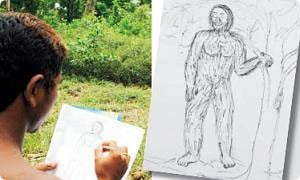The news coming out of Malaysia gets more and more interesting every day. Craig Woolheater’s "Malaysian Bigfoot = Surviving Homo erectus?" contains information from Singapore’s Peter Loh, wherein some remarkable potential findings are shared.

Photographs, according to naturalist and cryptozoologist Vincent Chow, have been taken by local people of these "Bigfoot" or locally termed "Mawas." The images are so good, according to their descriptions, reported from the news conference by Peter Loh, that the genitalia are visible.
Think about it. Right now, scientists do not even know if there is sexual dimorphism – a specific concept that encompasses a clear difference between genders in certain species of animals – in Homo erectus. Do you realize what a discovery like this could do to anthropological theory?
According to an exchange I’ve had with Peter Loh, he says that "Chow claimed during the interview that the female creature (creatures?) in the photographs looked rather feminine (I guess he meant in human standards). I take that to mean these creatures are hominid, or at least that was what he implied. I think Dr. Chow was referring to the face when he said it was rather feminine. I came to that conclusion because he waved his hand over his face when he said that."

Just as mentioned in The Field Guide to Bigfoot and Other Mystery Primates, there appears to be plenty of previous evidence for the existence of the survival of non-Homo sapiens species. Look closely (below), without bias, at the drawings coming out of Malaysia. As opposed to imaginary creatures, we are seeing people drawing real hominoids with real body parts.

When Vincent Chow shows his photographs of these alleged Homo erectus with female gentialia and wrinkled faces, I shout a hearty "Congratulations" to him. Yes, as he says, many will have the last laughs on this one. I will be especially happy for all the eyewitnesses who have had to tolerate ridicule merely for reporting what they saw.
The reality of a living fossil existing such as Homo erectus will be earthshaking. Within the study of early hominids, a debate rages on as to where fossil finds of erectus should be placed. The Johor Mawas revealed and discovered will impact on this question, if they turn out to be erectus.
Speaking of a 2004 fossil discovery of nearly a million year old, we hear of the typical divisions in the debate: "Palaeoanthropologists often have this assumption that every hominid found from that time period is a H. erectus," said Jeffery Schwartz, of the University of Pittsburgh. "They group hominids not on the basis of what they look like, but the time when they lived, which is totally unfounded. There is a tradition of confusing diversity with variation."
If Chow’s findings pan out in Malaysia, look for some revolutionary new thoughts within anthropology, palaeoanthrology, hominology, and cryptozoology.
As Vincent Chow has told me, what he is talking about are "photographs of the real McCoys."
Of course, presently, no telling what the photographs will show, but as far as being involved with this project, I am happy to announce I will be one of the contributors to his book. My interest is in honestly giving my opinion of what I do see and talking about it in the context of other mystery primate investigations.
Like many of you, I can hardly wait for this whole story to unfold, but I will. I respect the timeframes that Chow and the photographer need regarding this evidence.

Summary of responses:
Yes, potential is a key word.
No one said that Homo erectus was a new theory. Hey, that’s why I pointed out that in my and Patrick Huyghe’s field guide we discussed a type, the Erectus Hominid.
We all can be excited but still be careful, correct? Until something is shown and proven, of course, this is all premature intrigue. But what’s wrong with that?
I am awaiting photographic evidence.
The picture (no pun intended) is confusing out of Malaysia, and I think some people under comments are confusing different reports of different things.
The footprints that look like rhinos, thus, may be tracks of rhinos. They may have nothing to do with Malaysian Bigfoot, other than people labeling them as Bigfoot.
The Mawas may be different than some other reports of Bigfoot, Orang Dalam, and more.
Homo erectus are varied in size. That’s the point in bringing up the business about their variation and diversity.
The “Giant Java Man” may be an evolved form of Paranthropus or Homo erectus. We are working in the neverneverland of theories and suggestions here.
Bring on the photos of the Mawas!
Sexual dimorphism is the systematic difference in form between individuals of different sexes in the same species. There is some debate that among fossil hominids, fossil hominoids, and fossil anthropoids, sexual dimorphism may not be clearcut.
Believe it or not, even sexual dimorphism in humans is the subject of controversy, especially related to mental ability and psychological gender.
Homo sapiens has a low level of sexual dimorphism compared with many other species. Standard growth curves for male and female humans have an overlap that is slightly less than 1 standard deviation.
I guess we all will have to wait to see if anything comes of the Malaysian developments to know.
The prints found may have nothing to do with the Mawas reported by Chow.